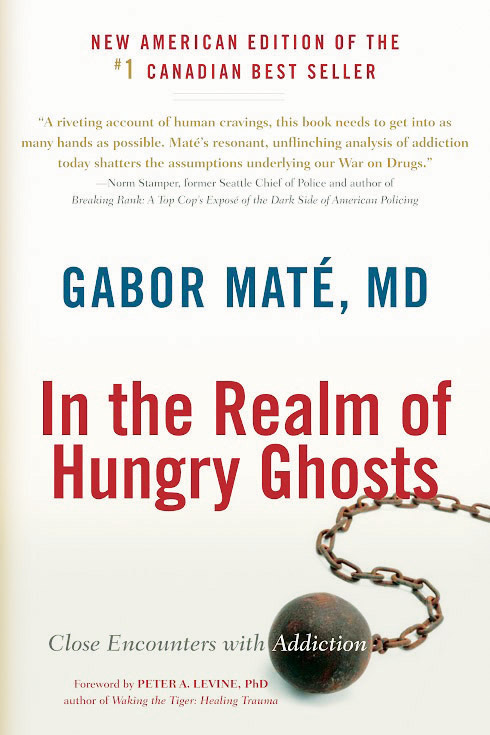 In the Realm of Hungry Ghosts: Close Encounters with Addiction
In the Realm of Hungry Ghosts: Close Encounters with Addiction
Gabor Maté, MD
North Atlantic Books
(2010)
493 pages
“The mandala, the Buddhist wheel of life, revolves through six realms,” begins Dr. Gabor Maté in his No. 1 bestselling book “In the Realm of Hungry Ghosts: Close Encounters with Addiction.”
“The inhabitants of the hungry ghost realm are depicted as creatures with scrawny necks, small mouths, emaciated limbs, and large, bloated empty bellies. This is the domain of addiction, where we constantly seek something outside ourselves to curb an insatiable yearning for relief or fulfillment.”
Maté’s reason for writing is to discover the cause of addiction — to understand the addiction-prone personality as well as what “happens psychologically in the brains of addicted people.” Maté is also interested in how the addictive mind becomes “not addicted.” True to the Hippocratic Oath of “first do no harm,” he is, above all, interested in the possibility of healing.
Maté posits that the experience of early trauma, not genetics, causes addiction. “Brain development in the uterus and during childhood is the single most important biological factor in determining whether or not a person will be predisposed to substance dependence and to addictive behaviors,” Maté writes.
This is not a new claim in the scientific community, and Maté supports his thesis with a barrage of scientific research by leading experts in the fields of neuroscience, psychology and genetics. Here, Maté describes the role of “good stimulation” and “bad stimulation” in the developing brain. Simply put, too much “bad stimulation” in childhood distorts brain development and lays the groundwork for drug addiction later in life. For example, children taken away from their primary attachment figure develop high stress levels in their brains, which negatively influences brain development, correlating to drug addiction as youths and adults.
But it is Maté’s work with patients that forms the meat of “Hungry Ghosts.” Maté draws upon his sojourn as resident physician for the Vancouver Skid Row clinic, serving residents of the Portland Hotel Society, a group of shelters for people suffering from addiction. Maté details case study upon case study of people addicted to the substances that will eventually destroy them. Patients with heart problems, AIDS, abscesses and cancers from drugs cannot stop. Patients who have seen relatives, friends and lovers killed due to drug addiction cannot stop these same drug addictions, either. There is only the longing for the next hit, the next escape from self.
“Much as I want to accept them, at least in principle,” admits Maté, “some days I find myself full of disapproval and judgement, rejecting them and wanting them to be other than who they are.” The honesty here — and in detailing his own addiction to work and shopping — creates trust in Maté as a reliable narrator, observer and man of medicine. He does not pretend to be perfect. He does not pretend to be without bias. He only claims to try his best.
And Maté does. In the midst of a steady stream of overdoses and deaths, he remains, ministering to the sick.
Yet why do addicts remain addicted? “The question is never ‘Why the addiction?’ but ‘Why the pain?’” explains Maté. “The research literature is unequivocal: most hard-core substance abusers come from abusive homes.” The pain is so severe that the person will do anything do avoid it, thus beginning the use of substances. And then, “the addict comes to depend on the substance or behavior.”
Addiction spirals into social ostracization, further alienating the addict from community and help. Maté also connects the dots between the relationship of mental illness and addiction, and touches upon the documented history of excessive police brutality against addicts. He looks at public policy surrounding addiction — specifically the war on drugs — to find better, “evidence-based approach to the treatment of severe drug addiction.”
If we are willing to do the emotional, psychological and spiritual work, then there is hope, Maté proffers. Through gaining awareness of emotional stressors and the use of meditation — through “compassionate curiosity,” which transforms a person’s relationship to addiction — much healing work can be done. Maté also notes the usefulness of “4 Step” and “12 Step” programs in overcoming addictions. For despite the early trauma that caused a plunge into addiction, the human brain is endlessly adaptable, able to learn new pathways within a beneficial environment. “The possibility of renewal,” writes Maté, “exists so long as life exists.”
Part case study, part history, part memoir, part scientific research and analysis, “In the Realm of Hungry Ghosts” is a necessary book. Maté’s writing style is clear and engaging — a pleasure to read. He seamlessly combines the personal, anecdotal and scientific. This is the type of book that bridges the gap between scientist, youth worker and layperson. For anyone who works with addiction, has lost loved ones to addiction, or has suffered from addiction, this is required reading. But with its large focus on childhood stimulus as the root of addiction in later life, “Hungry Ghosts” is especially applicable to youth workers. By allowing them a greater holistic picture of the causes of addiction, more successful programming services, treatment options and preventative addiction measures can be implemented.
Further Reading
- “The Selfish Brain: Learning from Addiction,” by Robert L. Dupont, MD (March 2000) by Hazelden Foundation, discusses the effects of addiction on the brain.
- “The Mind and the Brain: Neuroplasticity and the Power of Mental Force” by Jeffery Schwartz and Sharon Begley (October 2003 ), published by HarperCollins Publishers, describes the adaptability of the brain and the brain’s ability to learn new behaviors.

























